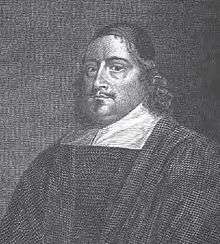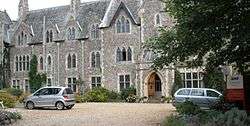Corporation of the Sons and Friends of the Clergy

The Corporation of the Sons and Friends of the Clergy is a charity resulting from an amalgamation in 2013. The two parent organisations date from 1655 and 1820, respectively. It exists to provide financial support to clergy of the Anglican Communion who are diocesan clergy in a diocese of the British Isles (including the United Kingdom and Ireland, and the Crown dependencies of the Channel Islands and the Isle of Man) or missionary clergy serving overseas with a society based in one of those countries. It also provides assistance to clergy widows, children, and orphans, and to members of Anglican religious orders within the British Isles.
Foundation
The Corporation of the Sons of the Clergy was established in 1655 in response to the distress of the large number of clergymen who were dispossessed of their livings under the regime of Oliver Cromwell. Those who were loyal to the crown and adhered to the traditional form of service were displaced. One of the main instigators of the charity was Edward Wake, who was uncle of William Wake Archbishop of Canterbury. The founders were merchants of the City of London and priests of the Church of England, all of whom were themselves sons of clergymen.[1] The first fund-raising events were on 8 November 1655, when a Festival Service was held in Old St Paul's Cathedral, followed by a dinner in the Merchant Taylors' Hall. Collections were taken at each and these events have continued ever since. The charity also had generous support from important and influential people.
Royal Charter
When Charles II came to the throne, the supporters of the charity sent a message of loyal greeting and in 1678 the King granted the charity a Royal Charter. This Charter committed the administration of the “Charity for Releefe of the poore Widdowes and Children of Clergymen” to a “Court of Assistants”. The Court of Assistants consisted of a President, a Vice-President, three Treasurers and up to forty-two Assistants, elected each year from the Governors. The Court first met on 15 July 1678 in the Jerusalem Chamber at Westminster Abbey. The Corporation’s President was John Dolben, Bishop of Rochester and Dean of Westminster, whilst the Vice-President was Sir Christopher Wren.[1]
Sons of the Clergy
As time passed the Corporation, maintaining its full name, but commonly operating under the shorter name "Sons of the Clergy", became a wider charity for clerical families and provided support such as the payment of the apprenticeship indentures. The charity obtained properties such as a house in Salisbury Square and other church land, and advowsons. The charity was not free from abuse. In 1731 Valens Comyn achieved great distinction in its service by uncovering the fraudulent activities of one of the Treasurers, who had been double listing widows whose pensions he was responsible for paying and lining his pockets on the proceeds.
Friends of the Clergy
In 1820 another charity was established for the relief of poor clergymen and their families. Founded by Phyllis Peyton and Mary Lamb, the "Clothing Society for the Benefit of Poor Pious Clergymen" grew rapidly, and following several changes of name (and amalgamations with smaller charities, culminating in the Friends of the Clergy Corporation Act 1972), became in modern times the Friends of the Clergy Corporation.[1]
Amalgamation of charities
During the twentieth century the Sons of the Clergy Corporation and the Clergy Friends Corporation found increasing opportunities to support each other's work, and to cooperate on charitable projects. In 2005 they committed to finding a route to permanent union, with widespread sharing of resources. In 2006 they began a process of "common trusteeship" whereby the same people were appointed as Trustees of both charities. In 2007 the two Corporations moved into a single headquarters together, with a totally unified staff, remaining separate entities only in a legal and accountancy sense. The process of formally amalgamating the two Coprorations was complex, but was completed in 2013, when the Corporation of the Sons and Friends of the Clergy came into being.
Modern operations
The Corporation today is the largest charity helping clergy of the Anglican Church in times of personal hardship, as well as their widows, dependants, and elderly unmarried daughters. In 1998 Clark reported in the Independent that in the previous year 3,500 clergy had resorted to one of the two charities (still independent of each other at that date). The combined Corporation is based at 1 Dean Trench Street, Westminster. In 2013 the Corporation's income was 3.7 million pounds.[2]
Anglican clergy today receive broadly comparable stipend payments, unlike an earlier age when levels of payment varied enormously, according to the assets of the individual parish. Nonetheless, clergy and their dependants still sometimes find themselves destitute or in financial hardship. Grants are also made to assist clergy with the provision of domestic activities otherwise unaffordable, such as lessons on musical instruments for their children, or holidays. During the 1970s and 1980s the Corporation maintained and operated Chatsworth Gardens in Eastbourne as a clergy holiday home. This very large house, donated by the elderly owner during her lifetime, was converted into a series of large apartments, and whilst the donor continued to live in one herself, the others were maintained by the Corporation as clergy holiday flats. Many clergy families of that era have common memories of the Eastbourne clergy holiday homes. Chatsworth Gardens was however an expensive asset, and was eventually sold.
The annual Festival service, commenced in 1655, has continued ever since, and is a major event annually on the calendar of St Paul's Cathedral.[3] All senior British Anglican clergy are involved with the Corporation, with the Archbishop of Canterbury serving as President.[4]
Clergy Orphan Corporation

The Clergy Orphan Corporation (COC), founded in Yorkshire in 1749, was fully incorporated into the Corporation of the Sons of the Clergy in 1997, and ceased to exist independently. Until that time the COC had operated two independent schools, originally for the orphans of clergy, but latterly being general independent schools, with places reserved for clergy orphans as Foundation pupils. These schools, St Edmund's School, Canterbury (for boys), and St Margaret's School, Bushey (for girls) were removed from the charity at that time, and now exist as independent foundations.
Incorporated bodies
Over the many years of history of this charity, its legal status has changed several times, and a large number of smaller charities have been incorporated into it by merger, amalgamation, or takeover. The following former clergy charities are all now incorporated into the current day Corporation of the Sons and Friends of the Clergy.
- Corporation of the Sons of the Clergy
- Friends of the Clergy Corporation
- Clergy Orphan Corporation
- Charity for Relief of the poor Widows and Children of Clergymen
- Clothing Society for the Benefit of Poor Pious Clergymen
- Poor Parochial Clergy Society
- Poor Clergy Relief Corporation
- Curates Augmentation Fund
- Society of Stewards and Subscribers for Maintaining and Educating Poor Orphans of Clergymen
References
- 1 2 3 "Clergy Charities". Clergy Charities United Website. Retrieved 22 September 2014.
- ↑ Annual financial summary at the UK Charity Commission website.
- ↑ Report of the 2013 event.
- ↑ See reference by Archbishop Williams.
Sources
- Gentleman’s Magazine; March 1785
- Gentleman's Magazine; January 1817
- COX, Nicholas Bridging the Gap: A History of the Corporation of the Sons of the Clergy Over 300 Years, 1655-1978. Oxford: Becket Pubns, 1978, ISBN 0-7289-0002-5.
- Ross Clark '"Poverty in the vicarage" Independent, The (London), Sep 14, 1998